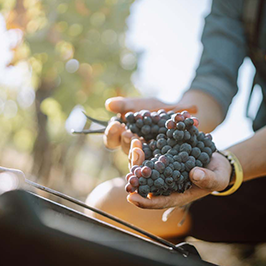We have planted old un-cloned varieties that have low yields but offer exceptional organoleptic richness.
As a result, our vineyard has become a museum of grape varieties. A remarkable story to discover…
In the 1950s, agriculture was taken over by an “industrial” approach. In the vineyard, clonal selection became standard: compared to past centuries, yields doubled, and the originality of the flavours tended to disappear.
At Mas de Daumas Gassac, we refused the clones: we planted old varieties with low yields. In this way, the vineyard has become something of a museum, illustrating what varieties such as Cabernet-Sauvignon, Petit Manseng and Viognier were like in the past. Before modern clones: low yields but tremendous organoleptic richness.
“Cloning changed yields, at least doubling them. We went from an exceptional product with a great aromatic intensity to an overabundant one, lacking in any flavours except those that are added artificially. We have kept the names of the grape varieties, but by cloning them, they have lost their diversity, their aromatic qualities… their personalities.”
Aimé Guibert
Low yields: a tradition in times past!
35 to 40 hectolitres per hectare. That means three to six thousand kilos of grapes per hectare, corresponding to one square metre for each glass of wine, and hence to a strong expression of the terroir.
These are modest yields when compared to the twenty to thirty thousand kilos of grapes per hectare that are harvested in the production of industrial wines.
Following the collapse of the glove-making trade, Aimé Guibert made a series of journeys to say goodbye to all the people he had worked with in the northern Mediterranean region. He took advantage of these occasions to ask, as a souvenir of their collaboration, for a cutting from their favourite vines, or those grown by friends, neighbours and families, each of which represented a period glory in a different region of the world… And so, it was that Aimé’s precious collection of varieties grew through such encounters and a constant search for authenticity. A collection of which the Gassac valley is now the guardian, and with reason: of the property’s 26 varieties, 14 are unknown to the general public and can truly be said to belong to history!
Red grape varieties
Most of the vineyard consists of the “king”, Cabernet Sauvignon, in uncloned form (as it grew in the Médoc before 1914).
Advised by their friend Mr Boubals (a professor of viticulture at Montpellier University and director of the National School of Viticulture) Aimé and Véronique Guibert obtained cuttings from vines dating from the 1930s and 40s from around a hundred of the best properties in the Bordeaux and Lot-et-Garonne region.
In 1972, 17,500 uncloned Cabernet Sauvignon vines were thus grafted onto American rootstock. These in themselves constitute a unique museum of old vines planted in the Médoc before the age of cloning.
In addition, 20% of the vineyard is planted with other noble varieties that are blended with the Cabernet Sauvignon: Cabernet Franc, Malbec, Merlot, Tannat, Petit Verdot, Syrah, Pinot Noir and six other rare, old varieties.
White grape varieties
Like the red, the white varieties come from old uncloned collections. Four varieties make up 90% of the white grapes: Viognier, Chardonnay, Petit Manseng and Chenin. Cuttings collected by Aimé from properties in their respective regions:
- Viognier from the Rhône: cuttings from the iconic Domaine Georges Vernay – Condrieu.
- Petit Manseng from the Pyrenees: Domaine Charles Hours – Béarn, Jurançon Grands Vins
- Chenin from the Loire: Domaine Huet – Vouvray.
- Chardonnay from Burgundy: Domaine des Comtes Lafon.
Note that while these four varieties account for 90% of the white wine, the remaining 10% comes from eight other varieties: Marsanne, Roussanne, Petit Courbu, Muscat Petit grain, Muscat d’Alexandrie, Gros Manseng, Semillon (France), Fiano (Italy).
These varieties constitute the only collection of its kind in the world, and tell a story that today is passed on through Mas de Daumas Gassac’s grand vins.





